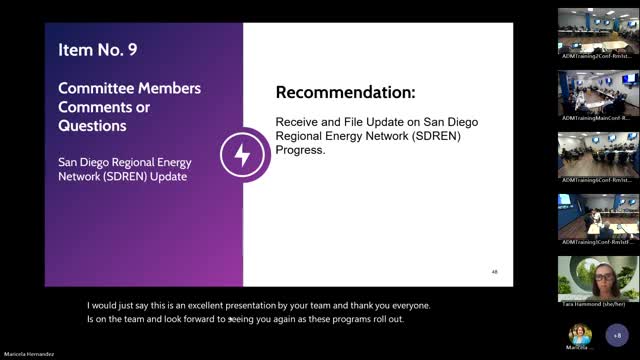San Diego Community Power posts 2024 power content label; staff say renewable share rose to 53% on core product
October 10, 2025 | San Diego Community Power, San Diego County, California
This article was created by AI summarizing key points discussed. AI makes mistakes, so for full details and context, please refer to the video of the full meeting. Please report any errors so we can fix them. Report an error »

San Diego Community Power staff presented the 2024 Power Source Disclosure and Power Content Label at the Community Advisory Committee meeting on Oct. 9, noting that the agency’s product mix improved year over year and that more contracted projects will raise carbon‑free shares in coming years.
Kenny Key, director of power contracts, explained the annually required audit and public disclosure process overseen by the California Energy Commission and said the agency had posted the standardized state template. “High level… our PowerOn, which is most of our customers, is at 53% renewable,” Key said, adding that a small large‑hydro percentage brought PowerOn’s total carbon‑free share to about 55%.
What the label shows
Under the state’s new standardized template for 2024, Community Power’s 100% products (Power100 and Power100 Green Plus) are reported as 100% renewable. The agency’s primary default product, PowerOn, was reported at 53% renewable in 2024 and roughly 55% carbon‑free when large hydro was included. Key noted that unspecified energy — power purchased without a specific tracking tag — still carries a relatively high greenhouse gas emissions factor based on legacy (circa 2010) grid assumptions, which can make some portfolio emission metrics appear higher than current grid conditions might suggest.
Future changes and Diablo Canyon
Key told the committee that Community Power’s planned inclusion of an allocation from Diablo Canyon nuclear will further increase carbon‑free percentages on future labels and that several long‑term contracted projects are scheduled to come online in 2026. He said the agency expects 2026 to show the largest change, with several projects and the nuclear allocation lowering PowerOn’s emissions relative to the California utility average.
Communication and customer questions
Key warned committee members that the new state template can be confusing for customers because a small pie chart lists “carbon‑free” while a separate line lists “renewable” percentages; the two visual elements do not align intuitively. The California Energy Commission requires the template and the agency must mail the consumer disclosure to customers by year’s end; staff said they will add clarifying messaging on mailers and website text to reduce confusion.
Ending
The committee received the update; no vote was required. Staff encouraged CAC members to share the posted label and said mailers would go out in December.
Kenny Key, director of power contracts, explained the annually required audit and public disclosure process overseen by the California Energy Commission and said the agency had posted the standardized state template. “High level… our PowerOn, which is most of our customers, is at 53% renewable,” Key said, adding that a small large‑hydro percentage brought PowerOn’s total carbon‑free share to about 55%.
What the label shows
Under the state’s new standardized template for 2024, Community Power’s 100% products (Power100 and Power100 Green Plus) are reported as 100% renewable. The agency’s primary default product, PowerOn, was reported at 53% renewable in 2024 and roughly 55% carbon‑free when large hydro was included. Key noted that unspecified energy — power purchased without a specific tracking tag — still carries a relatively high greenhouse gas emissions factor based on legacy (circa 2010) grid assumptions, which can make some portfolio emission metrics appear higher than current grid conditions might suggest.
Future changes and Diablo Canyon
Key told the committee that Community Power’s planned inclusion of an allocation from Diablo Canyon nuclear will further increase carbon‑free percentages on future labels and that several long‑term contracted projects are scheduled to come online in 2026. He said the agency expects 2026 to show the largest change, with several projects and the nuclear allocation lowering PowerOn’s emissions relative to the California utility average.
Communication and customer questions
Key warned committee members that the new state template can be confusing for customers because a small pie chart lists “carbon‑free” while a separate line lists “renewable” percentages; the two visual elements do not align intuitively. The California Energy Commission requires the template and the agency must mail the consumer disclosure to customers by year’s end; staff said they will add clarifying messaging on mailers and website text to reduce confusion.
Ending
The committee received the update; no vote was required. Staff encouraged CAC members to share the posted label and said mailers would go out in December.
View full meeting
This article is based on a recent meeting—watch the full video and explore the complete transcript for deeper insights into the discussion.
View full meeting
